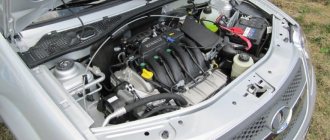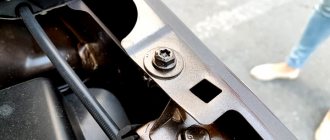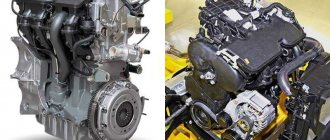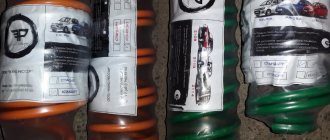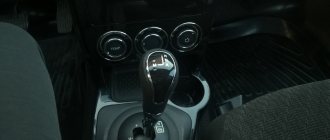Motor 11189 is a widespread power unit from the Kalina family, which is installed on such car models as Lada Vesta, Lada Granta, and more recently on Lada Largus. Engine 11189 was first introduced back in 2016 and is essentially a modern modification of an earlier version of engine 11186 for the Lada-Largus model. The assembly of this engine is carried out in the city of Togliatti Automotive.
general information
Important information about the car 11189 is considered a logical continuation of the power unit labeled 11186, but improved and modified. To understand what we are talking about, let’s visually analyze the technical characteristics of the 11189 engine.
The 11189 power unit has been assigned the Euro-5 environmental standard, unlike other similar engine models. Due to the high technical characteristics and low cost of the engine, from 2021 it was decided to use the 11189 engine in the Lada Largus instead of the more expensive K4M and K7M engine models produced by Renault.
As practice has shown, many motorists liked the new modification of the engine. The main role in this was played by the advantages of the 11189 engine, such as a simple design and relatively cheap spare parts.
Comparison of configurations and prices
Renault Docker is sold on the Russian market in three trim levels, differing from each other in power units and the presence of one or another additional equipment. At the same time, for the simplest version in the showrooms of an official dealer they ask about 900,000 rubles. But even in this option, the car will have everything you need to ensure minimal comfort and safety.
Its rival Lada Largus offers buyers a choice of six trim levels: Classic, Comfort, Standard, Luxe, Luxe Prestige and CNG Luxe. The versions differ in engine type and additional options. In addition, the car can be purchased in both a five-seater and a seven-seater version. His opponent does not have such an opportunity, nor does he have such a wide choice of configurations. And a Russian car costs an order of magnitude cheaper than a French one. In its minimum configuration, it can be purchased for about 620,000 rubles. But at the same time, the equipment of such a station wagon will be slightly worse than the French one in the cheapest version.
Briefly about the design of the 11189 engine
The cast-iron body for four cylinders is similar to the one that was equipped with the VAZ-2108. Their only difference is that the cooling jacket of the 11189 engine is considered more developed. The increased thermal load of the engine required not only an increase in the number of channels for fluid circulation, but also the use of special nozzles that spray the lower part of the pistons with oil.
The block head is made of durable aluminum alloy with good technical characteristics. In the process of its production, strengthening heat treatment began to be used. The intake manifold in this engine model is more developed with an E-gas electronic throttle. It is worth noting that the catalyst is built into the exhaust. The single camshaft is rotated by a durable Gates belt with a claimed service life of 180,000 km. Experts call a noticeable drawback the lack of hydraulic compensators.
Options and prices
Standard
The minimum Standard configuration is available in a 5-seater version for 669,900 rubles. The head optics do not have an overly complex system or content. The lights and headlights received halogen filling, and the rear lighting equipment was reinforced with additional brake lights. The basic version includes heat-insulating glazing and heated rear window, which makes the car suitable for use in the Russian climate. The roof has durable roof rails for carrying cargo. Metallic paint is only available as an option, regardless of trim level. Inside, the driver can adjust the steering column vertically. The difference between the basic version is four headrests, in the rest their number increases to five. There is only one airbag. You will also have to fork out extra money for installing the ERA-GLONASS system. Motion control systems include ABS and EBD. In-cabin amenities are limited to a cabin air filter.
Classic
- power steering;
- mirrors in visors;
- central locking;
- electric drive for front windows;
- ERA-GLONASS.
Comfort
The Comfort package is also available in two seating options. The minimum will cost 672,900 rubles, the extended one will cost 23,000 rubles more. Moreover, this assembly has the ability to connect gas equipment from the manufacturer. For the version with a 106-horsepower engine and a gas-gasoline power system you will have to pay 872,900 rubles
Please note that in this case you can only count on five-person occupancy. The main changes were made to the interior, in particular, electric heating for the first row of seats, a second airbag and air conditioning appeared.
Users have access to a radio, CD player with MP3 support and Hands Free. Instead of two speakers, the “Comfort” version implies the presence of four with the ability to connect AUX and USB devices. A bonus is the height adjustment of the first row seat belts.
Luxe
The Luxe package opens up wide possibilities. The gasoline model will cost 706,900 rubles for 7 seats. Installing HBO automatically raises the price of the five-seater version to 893,900 rubles. The buyer can count on installation:
- front fog lights;
- heated and electric side mirrors painted in body color;
- painted door handles;
- decorative interior trim in black, gray and brown;
- driver's seat height adjustment;
- lumbar support on captain's chairs;
- full package of electric windows;
- remote control;
- rear parking sensors;
- on-board computer.
Luxe Prestige
The previous version came as close as possible to the flagship version Luxe Prestige, costing from 721,900 rubles for versions with a gasoline engine and 899,900 for the version with gas equipment on board. The differences are decorative: aluminum wheels, rear tinting, and a leather steering wheel appear. In September 2021, it became known about the release of a special version of the Lada Largus 2021 Club. The price for the modification is still unknown. The list of additions includes factory tinting and parking sensors. A badge with the hashtag #CLUB will be added to the interior and tailgate.
Options and prices (table)
| Equipment | Volume, l | Fuel | Motor, hp | Box | Dynamics up to 100 km/h, sec | Cool. moment, N×m | Drive unit | Maximum speed, km/h | Consumption in mixed cycle, l | Price, ₽ |
| Classic 5 seats | 1.6 | petrol | 87 | M.T. | 14.4 | 140 | front | 158 | 10.5 | 618 900 |
| Classic A/C 7 seats | 1.6 | petrol | 87 | M.T. | 15.4 | 140 | front | 158 | 10.5 | 648 900 |
| Luxe 7 seats | 1.6 | petrol | 106 | M.T. | 14.5 | 148 | front | 165 | 10 | 708 900 |
| CNG Comfort 5 seats | 1.6 | gas | petrol | 106 | M.T. | 13.5 | 148 | front | 165 | 10 | 874 900 |
| CNG Luxe Prestige 5 seats | 1.6 | gas | petrol | 106 | M.T. | 13.5 | 148 | front | 165 | 10 | 901 900 |
| CNG CNG Luxe 5 seats | 1.6 | gas | petrol | 106 | M.T. | 13.5 | 148 | front | 165 | 10 | 895 900 |
| Standard 5 seats | 1.6 | petrol | 87 | M.T. | 14.4 | 140 | front | 158 | 10.5 | 671 900 |
| Comfort 7 seats | 1.6 | petrol | 106 | M.T. | 14.5 | 148 | front | 165 | 10 | 687 900 |
| Luxe Prestige 7 seats | 1.6 | petrol | 106 | M.T. | 14.5 | 148 | front | 165 | 10 | 723 900 |
| Standard 5 seats | 1.6 | petrol | 106 | M.T. | 13.5 | 148 | front | 165 | 10 | 746 900 |
Prices for configurations are approximate and may vary depending on the region.
The difference between motor 11189 and motor 11186
The main distinguishing feature of the earlier engine model is the 39% lighter connecting rod and piston group. The use of tandem parts made it possible to significantly reduce engine noise and vibration while the vehicle was moving. The new anti-friction inserts in the piston design and thinner rings have reduced the finishing process to a minimum. However, the new model abandoned the holes on the bottom.
Engines Lada Largus
Since 2021, Renault engines have completely stopped being installed on Lada Largus station wagons. The K4M engine was replaced by the VAZ 21129 (16 valves). Two years earlier, in 2015, AvtoVAZ similarly abandoned the K7M engine in favor of the VAZ 11189 (8 valves).
The reason for the replacement is the cost of the motors. Domestic internal combustion engines are cheaper. But AvtoVAZ decided not to reduce the price of the Lada Largus, but to make the car more comfortable. The package includes athermal glass, a cabin air filter, a belt sensor, etc.
As part of the article, we will look at all 4 engines that were installed on the Lada Largus. K7M, K4M, VAZ 11189 and VAZ 21129.
Problems with the motor 11189
Despite all the advantages, with long-term operation of the 11189 engine, the following breakdowns may occur in Lada:
- Malfunctions in the operation of the indicators of the electronic throttle drive E-gas, which in most cases lead to the appearance of floating idle speed.
- Burnout of valves and malfunction of the ignition coil, which causes the engine to trip (1-2 cylinders of the engine stop working completely).
- Damage to the mass air flow sensor is considered the most common reason that the “iron horse” stalls while driving. A breakdown can lead to an accident.
- Overheating occurs, most often caused by an unreliable thermostat.
- Knocks and noises may be heard from under the hood. They appear mainly due to incorrectly set valve clearances.
- According to reviews, the 11189 engines have significantly reduced oil leaks compared to earlier engine models, but this problem has not yet been completely eliminated.
- Due to a design miscalculation, the occurrence of jamming of the water pump becomes inevitable for the engine. Experts recommend monitoring her condition with special attention.
The main drawback of Largus is the problematic and non-running VAZ engine. Review from the owner of Lada Largus
Now I understand why Largus with an aftermarket Renault engine are as good as new with a VAZ one.
I have owned a cross-country Largus in the maximum configuration for about a year. The engine is 106 horsepower, 1.6 VAZ. I didn’t plan to buy a domestic car, but it so happened that I needed an inexpensive, roomy car. What can I say about Lada Largus.
1. There are no special frills in the cabin, the tailgates swing open conveniently, the standard audio system surprised me with its sound, but the bluetooth doesn’t work very well in it. Removing the third row is very simple; the second row is secured with two bolts. With all the seats removed, you can load a couple of cubes of cargo.
2. The driver’s seat has no shape, the seating position is terrible, but I’m surprised that after three hours of a long trip I didn’t feel tired.
3. Legroom for second-row passengers is slightly less than for third-row passengers. There is no lighting above the second row, although there is above the third. Similarly with cup holders: there are for the third row, but not for the second. AvtoVAZ is burning.
4. The suspension works quite harshly: when passing speed bumps at low speed, you often feel a strong breakdown. It's like the shock absorbers are empty. Before that there was Sandero: you could fly over recumbents.
5. The gearbox shifts are tight, but I hope that this will go away with mileage. Due to the travel being too long, I sometimes release the clutch before engaging the gear. The gears themselves are long: in fifth at 120 km/h there are only 2.5 thousand revolutions.
6. Although the engine is 106 horsepower, it feels like there are no more than 80 horses - it doesn’t want to go at all. In order to drive at least somehow, you need to stick to 3-4 thousand revolutions, but then the roar of the engine is strong, and there is no particular sense. When you turn on the gas, there are more dips, but there are no significant changes. As a result, overtaking on the highways is still a gamble. If you try to move off without gas when it's cold, the car stalls.
From the moment I picked up the car at the dealership, vibrations were observed in 1-2 gears during acceleration, and on a warm car during acceleration. When coasting, there are no problems. I complained to the dealer several times, and as a result, I proved that there was a malfunction. The right drive was replaced, the vibration decreased, but did not stop at all. The dealer said that noise and vibration do not affect the basic functions of the car, and therefore are not covered by the warranty. There is no time to sort things out with them, I had to continue driving as is, with vibrations.
I didn't expect anything good from the purchase, but everything turned out to be even worse. One can only guess how people drive an 87-horsepower engine, but I understood why among used ones. Largus cars equipped with a Renault engine are more valuable. You can’t find anything domestic under the hood: the wiring is Chinese, the gearbox is from Renault, the abs is from Bosch. But they installed our motor and it ruined everything. Still, judging by the reviews, there are far fewer problems with the Renault engine.
At 6 thousand mileage the check light came on and the engine began to stall. I thought about it and made an appointment with the dealer, but then the indicator went out and the car started up. The scanner did not reveal any errors; I refused to visit the dealer so as not to pay more for diagnostics.
By 12 thousand I figured out the problem, or rather diagnosed it. The error appears periodically, for example, if there is not enough power and you turn on the gas, the engine may start to stall and the check light will light up (code 1304 or 0363). I'm guessing the misfire is due to a lean mixture and the cylinder is shutting down. Restarting the engine solves everything. I think that the reason is a flaw in the firmware for Euro-5, and in general, such errors are not uncommon on this engine, judging by the reviews.
Otherwise, during the operation of the car, my initial opinion has not changed: the main problem of Largus is the VAZ engine.
Text with slight editing: media.auto.ru/review/cars/vaz/largus/7951397/5665037772680233014/
www.lada-vesta2.ru
Oil and parts replacement schedule
The manufacturing plant of the 11189 Lada-Largus engine has outlined the following list, which indicates the replacement of consumable fluids and materials:
- engine oil and oil filters - once every 15,000 km;
- fuel and air filters, as well as spark plugs - every second technical control of the car’s condition;
- poly V-belt, wires and coolant - every 90,000 km.
Technical inspection and replacement of the above parts and fluids should only be carried out by an experienced car service specialist. According to reviews from car enthusiasts, valve clearances should be adjusted during each maintenance.
Options and prices: almost a monopoly
At the moment, for the current Lada Largus there are 4 configurations to choose from. Moreover, the first two versions are available in the cargo-passenger van version without rear glazing. Starting with the second Classic option, by paying an additional 23 thousand rubles to the price, you can get a third row of seats for additional seating for two people. The flagship 16-valve engine is an integral part of the passport data from the third configuration Comfort and higher.
Classic
The basic Classic version starts at 690,900 rubles. Such a low price is due to the minimal set of equipment. The equipment of the initial Largus includes only an adjustable steering column and a 50/50 folding rear sofa. Passive safety is provided only by the front driver's airbag. But for an additional fee, the body can be painted with metallic enamel.
Comfort
The Comfort package next on the list (see tables) is already capable of offering the necessary subsistence level. Buyers of this Lada receive: air conditioning, front power windows, power steering, central locking, heated seats, anti-lock brakes and a folding (60/40) second row. By purchasing Largus Comfort, the owner pleases himself with: a car radio with MP3, hands free and bluetooth telephone, remote control for central locking and a passenger airbag.
Luxe and Prestige
The Luxe version includes such useful things as height adjustment of the driver's seat, heated rear-view mirrors with a servo drive, an on-board computer, parking sensors, fog lights and power windows in the rear. Well, the flagship Prestige package gives the top Lada model only aluminum wheel rims.
Maintenance
Carrying out inspection, maintenance and analysis of the characteristics of the 11189 engine is practically no different from the standard procedure for similar VAZ engines. Maintenance includes the following actions:
- Change the oil once a year, or every 15,000 km. The specialist must fill in at least 3.2 liters of oil.
- Inspect and replace spark plugs at every oil change.
- Periodic inspection of the “heart” of the car to determine transmission and engine oil leaks. If any problems are discovered, it is important to resolve them quickly.
- Change the drive belt after a mileage of 40-60 thousand km.
Tuning
Literally all production engines that have eight valves are improved according to the same schemes. The VAZ-11189 engine is no exception, the characteristics of which make it possible to quickly modernize the engine.
Popular methods of tuning the power unit:
- Replacing the standard internal combustion shaft with a “Nuzhdin 10.93 (phase 282)” or “OKB Dinamika 108” shaft.
- Equipped with split gear.
- Forming the exhaust using a spider 4-2-1.4. Mounting on top of the receiver cylinder head 5.
- Setting the valve timing.
If the above steps are performed by an experienced specialist, then it is quite possible to increase the engine power to 100 hp. With.
Repair of power unit components
As practice shows, nothing lasts forever, and neither do the components of VAZ power units. In this part of the article, we will consider the main malfunctions, as well as methods of elimination and repair.
Timing belt or how not to bend valves
Probably the most interesting question for most motorists is whether the valves on VAZ engines bend? As for the VAZ 11189 engine, we can say with confidence that the valves bend when the timing belt breaks. Of course, valves can bend for other reasons, but the most common is considered to be a broken timing belt.
Another question that car enthusiasts ask in car repair shops and on forums regarding the timing belt is how to prevent valve bending? Everything is very simple - change the timing belt and rollers according to the technical recommendations of the manufacturer. Thus, in the maintenance manuals for engine 11189, the recommended belt replacement period is 45-50 thousand kilometers.
What happens if the valve bends? Everything is very simple - after the valve mechanism is bent, such important elements as the valve guide, valve seat, and oil seals fail. Subsequently, it may happen that this problem affects the piston mechanism. In a word, if the valve bends, then you should hope for the best and expect the worst - that is, a major repair.
How to replace the timing belt and rollers:
- First, you need to remove the protective casing.
- Then, we fix the camshaft, but before that it is necessary to set the timing marks.
- Unscrew the tension roller to release the belt.
- Next, we dismantle the belt itself.
- We change the tension roller.
- Reinstall the timing belt.
The procedure for changing the timing belt, at first glance, seems to be quite simple, but not everything is so simple, and not every car enthusiast will be able to carry it out. Therefore, in order not to subsequently bend the valves, it is recommended to contact specialists at a car service center to carry out the procedure.
Water pump malfunction
The water pump circulates coolant through the engine system. This is done for cooling and to prevent the motor from burning out. The failure of such a unit means that further operation of the power unit is impossible, since overheating will occur and the first thing that will be affected is the cylinder head. To avoid this, you should regularly diagnose the part and replace it on time.
There is nothing difficult about replacing the pump. The procedure is similar to changing the timing belt. After removing the belt, unscrew the bolts securing the water pump and replace it. It should be noted that the coolant must be drained from the system and, after replacement, topped up to the required level.
ECU diagnostics
One of the most common procedures that motorists carry out is diagnosing faults in the electronic engine control unit. This procedure is often performed in a car service center, since not every driver has a special portable diagnostic PC.
Installation of the turbine on the engine
The simplest option for turbocharging 11189 engines is considered to be the use of kits based on the Garrett 17 turbine. Using this kit, it is quite possible to increase the power of the “heart” of the car to 130 hp. With.
Today, there are other methods for installing a turbine, but they require large investments and labor costs. In addition, such engines, when turbocharged, are considered very sensitive to detonation, which as a result leads to a decrease in engine life and the need for expensive repairs in the future.
Increase engine power 11189 to 180 hp. With. it is quite possible by replacing the 8-valve cylinder head with a 16-valve one. After carrying out such actions, you can use any of the above methods to tune the engine.
Technical characteristics and reasonable sufficiency
As mentioned above, the new Largus 2021 model year will retain the same filling. Technical characteristics, as before, will imply the presence of two power units of the same displacement, but with different cylinder heads. The eight-valve variant now develops 90 (+3) power and 140 Nm of torque. The engine, which has a 16-valve gas distribution mechanism, shows an output of 106 hp. and 148 Nm. Both engines are paired with a 5-speed manual transmission.
Dynamics and valves
The minimal difference in torque means that when used in urban conditions, the base unit is not much inferior to its multi-valve counterpart. The technical specifications of the Lada Largus state 14.0 seconds acceleration to hundreds, a top speed of 160 km/h, and an average consumption of 8.2 liters per 100 km. The benefits of the 106-horsepower engine will be most felt on the highway, but the maximum capabilities are also low. It will take 13.5 seconds to reach the first hundred, and you will be able to reach 165 km/h. High power is not a hindrance to efficiency, and the passport data indicates 7.9 liters of average gasoline consumption.
Engine cost 11189
Buying such a used engine is not as easy as it might seem at first glance. This model of power unit is not very common in domestic car dismantling yards. Almost always, the only option for purchasing it is to contact an official dealer. It is quite rare to find offers to sell a used engine for 27 thousand and a new one for 70 thousand rubles.
Owners of Lada Largus cars with such an “iron heart” praise their unit for its excellent traction even at low speeds, safety, durability and efficiency. In addition, the price of car servicing and spare parts is affordable.
The 11189 engine is a very common engine that is equipped in many vehicles produced by. The quality and technical parameters of the product are not inferior to many domestic analogues, which are sold on the car market at a high price.
Engines and transmission
Both manufacturers produce their cars with several types of engines for customers to choose from. In the first case, there are both gasoline and diesel engines with the following characteristics:
- gasoline, volume 1.6 liters with a power of 85 horsepower;
- petrol turbocharged with a volume of 1.2 liters and a power of 115 hp;
- 1.5 liter diesel with a capacity of 75 “mares”;
- diesel, volume 1.5 liters, power 90 “horses”.
The Russian car can have the following power units:
- gasoline, volume 1.6 liters, power 87 hp;
- volume 1.6 liters, petrol, developing power up to 106 “horses”;
- volume 1.6 liters, bi-fuel (gas, gasoline) with a capacity of 106 horsepower.
Station wagons do not have impressive speed characteristics. True, Renault in versions with the most powerful power units has a slightly better figure than Lada. But despite this, cars are more designed for calm drivers. At the same time, they are fuel efficient. And the Russian bi-fuel version is a super economical option for those who travel a lot and are not ready to pay a lot of money for gasoline.
Both cars are available for sale only with a manual transmission.
Both the Frenchman and the Lada Largus are exclusively front-wheel drive cars.
